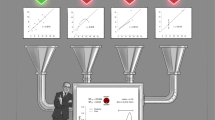Abstract
The qualitative reasoning (QR) field has developed various representation and reasoning methods for the modeling with incomplete information or incomplete knowledge. While most uncertain reasoning approaches describe uncertain or imprecisely known information as probability distribution functions, qualitative reasoning bases its model specification on qualitative descriptions that are derived from known qualitative system properties. Problems are formulated as sets of qualitative constraints and their analysis is performed by applying a qualitative calculus. This paper presents a general, unifying theory of the various existing qualitative reasoning systems that includes, as special cases, reasoning methods that use representations of qualitative differential equations and qualitative difference equations. Based on set theory, our QR framework describes fundamental concepts such as qualitative models and solutions, and relates them to the quantitative analogues of its underlying quantitative reference system. Our motivation arises from the types of models found in the management sciences. Thus we emphasize the significance of discrete, dynamic models and optimization models in the business management and economics fields, both of which have received less attention in current QR research. Finally, we extend our theoretical framework to include an approach to qualitative optimization.
Similar content being viewed by others
References
Allen RGD. Mathematical Economics, London: MacMillan, 1956.
Alpar P, Dilger W. Market share analysis and prognosis using qualitative reasoning, Decision Support Systems 1995;15(2):133-146.
Ba S, Lang, KR, Whinston, AB, Enterprise decision support using intranet technology, Decision Support Systems 1997;20(2):99-134.
Bailey AD, Kiang MY, Kuipers, B, Whinston AB. Analytic procedures and qualitative reasoning in auditing. Applications in Management Science, JAI Press, 1991.
Benaroch M, Dhar V. Controlling the complexity of investment decisions using qualitative reasoning techniques. Decision Support Systems 1995;15(2):115-132.
Berleant D, Kuipers B. Qualitative and quantitative simulation: Bridging the gap. Artificial Intelligence 1998;95(2):215-255.
Bobrow DG. ed., Reasoning about Physical Systems. Cambridge, MA: MIT Press, 1985.
Bredeweg B, Winkels R. Qualitative models in interactive learning environment. Interactive Learning Environments 1998;5:1-18.
de Kleer, J. A view on qualitative physics. In: Bobrow D. ed., Artificial Intelligence in Perspective. Cambridge, MA: MIT Press, 1993;105-114.
de Kleer J. Browne JS. A qualitative physics based on confluences. Artificial Intelligence 1984;24:7-83.
Dordan O. Mathematical problems arising in qualitative simulation of a differential equation. Artificial Intelligence 1992;55:61-86.
Escrig MT, Toledo F. Qualitative Spatial Reasoning, Amsterdam: IOS Press, 1998.
Farley AM, Lin KP. Qualitative reasoning in economics. Journal of Economic Dynamics and Control 1990;14,465-490.
Forbus KD. Qualitative process theory. Artificial Intelligence 1984; 24:85-168.
Forbus KD. Using qualitative physics to create articulate educational software. IEEE Expert 1997;12:32-41.
Goldberg S. Introduction to Difference Equations, New York: John Wiley, 1958.
Hinkkanen A, Lang KR, Whinston AB. On the usage of qualitative reasoning as an approach towards enterprise modeling. Annals of Operations Research 1995;55:101-137.
Hintikka J. Knowledge and Belief, New York: John Wiley, 1962.
Ingalls R, Morrice DJ, Whinston AB. The implementation of temporal intervals in qualitative simulation graphs. ACM Transactions on Modeling and Computer Simulation 2000;10(3):215-240.
Iwasaki Y. Real-world applications of qualitative reasoning. IEEE Expert 1997;12,16-21.
Iwasaki Y, Simon H. Causality in device behavior. Artificial Intelligence 1986;29:3-32.
Kiang MY, Hinkkanen A, Whinston AB. An interval propagation method for solving qualitative difference equations systems. IEEE Transactions on Systems, Man, and Cybernetics 1995;25:1110-1120.
Kuipers B. Qualitative simulation. Artificial Intelligence 1986;29: 289-338.
Kuipers B. Qualitative Reasoning, Modeling and Simulation with Incomplete Knowledge, Cambridge, MA: MIT Press, 1994.
Lenzen W. Recent Work in Epistemic Logic. Amsterdam: North Holland, 1978.
Lang KR, Moore JC, Whinston AB. Computational systems for qualitative economics. Computational Economics 1995;8(1):1-26.
Monge PR. Theoretical and analytical issues in studying organizational processes. Organization Science 1990;1:406-430.
Raiman O. Order of magnitude reasoning. Artificial Intelligence 1991;51:11-38.
Samuelson PA. Foundations of Economic Analysis. Cambridge, Mass: Harvard Univ. Press, 1947.
Simon H, Kalagnanam J, Iwasaki Y. The mathematical basis for qualitative reasoning. IEEE Expert 1991:11-19.
Simmons R. ”Commonsense” arithmetic reasoning. In: Proceedings AAAI-86, Philadelphia, PA, 1986:118-124.
Smith N. First steps in formalizing qualitative systems dynamics. In: Proceedings of the 14th InternationalWorkshop on Qualitative Reasoning, Morelia, Mexico, 2000:138-143.
Struss P. Problems of interval-based qualitative reasoning. In: de Kleer J. Wald D. eds., Readings in Qualitative Reasoning about Physical Systems. Los Altos, CA: Morgan Kaufman, 1990:288-311.
Weld DS, de Kleer J. eds., Reading in Qualitative Reasoning about Physical Systems. San Mateo, CA: Margan Kaufman, 1990.
Williams BC. A theory of interactions: Unifying qualitative and quantitative algebraic reasoning. Artificial Intelligence 1991;51: 39-94.
Wolstenholme EF. Qualitative vs. quantitative modeling: The evolving balance. Journal of the Operational Research Society 1999;50: 422-428.
Wyatt GJ. Leitch RR, Steele AD. Qualitative and quantitative simulation of interacting markets. Decision Support Systems 1995;15(2), 105-114.
Author information
Authors and Affiliations
Rights and permissions
About this article
Cite this article
Hinkkanen, A., Lang, K.R. & Whinston, A.B. A Set-Theoretical Foundation of Qualitative Reasoning and its Application to the Modeling of Economics and Business Management Problems. Information Systems Frontiers 5, 379–399 (2003). https://doi.org/10.1023/B:ISFI.0000005652.72048.4d
Issue Date:
DOI: https://doi.org/10.1023/B:ISFI.0000005652.72048.4d




